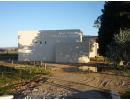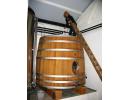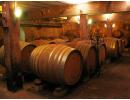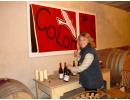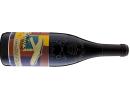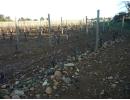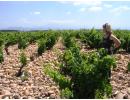Domaine Isabel Ferrando
Domaine Isabel Ferrando "Colombis” 2015 / 2014 - Châteauneuf du Pape
The wine is produced from 60+ year old Grenache vines from 3 "lieux-dits" known as “Colombis”, “Cristia” and “Les Roues”, each parcel representing 1/3 of the wine. The grapes produce a yield of 20 hl/ha, the fermentation is done in a conical oak vat for 5 weeks at 28°C and whole bunches are used since 2009 increasing the wines structure. The ageing will last about 18 months in 3 year old demi-muid barrels of 600 litres. No filtration is carried out.
PVins notes: The wine has great aromatic intensity of kirsch, spices and blackberry jam, it is medium to full-bodied and the oak is well integrated on the long finish. This is a great example of the potential of the Grenache varietal. Cellaring for the first 2-3 years after bottling is recommended and it will age over 10-20 years depending on the vintage.
2015
Wine Spectator 95
Offers gorgeous mouthfeel, with very fine-grained tannins thoroughly embedded into the core of crushed blackberry, raspberry puree and plum pâte de fruit flavors. Mouthwatering licorice snap, black tea and graphite notes drive the finish, adding serious length and depth. Integrated enough to be tempting now, but this will deliver much more after cellaring. Best from 2020 through 2040.
Wine Advocate 96
From some of the appellation's cooler sites and 60- to 80-year-old vines, the 100% Grenache 2015 Chateauneuf du Pape Colombis is a stunner. It has a true sense of garrigue, along with dark fruit, peppery spice and rich, velvety tannins. I wouldn't turn down a glass now, but it should be even better in a few years' time. Drink 2017 -2030.
Jeb Dunnuck 95
The 2015 Châteauneuf-du-Pape Colombis is a more open, sexy wine based on very old vine Grenache from the sandy soils of the Colombis, Cristia and Rayas lieux-dits. Framboise, incense, potpourri and floral notes all emerge from this pretty, elegant, complex Grenache that has sweet fruit, polished tannins and a great finish. Like all the 2015s, it's made in a more elegant style, yet still packs ample fruit. I’d happily drink bottles anytime over the coming 10-15 years.
La Revue du Vin de France 18
2014
Wine Spectator 94
Belies the generally approachable feel of the vintage, with a core of black currant, fig and raspberry pâte de fruit inlaid with Turkish coffee and melted black licorice notes. The long finish has serious tarry grip perfectly embedded in the fruit, so this should strut after some cellaring. Best from 2019 through 2029.
Wine Advocate 92-94
This cuvee is 100% Grenache that comes from three plots - Colombis, le Cristia and Les Roues -all of which are mostly sand and sandstone soils. Today it’s not destemmed and is aged in larger oak barrels. The 2014 Châteauneuf du Pape Colombis is a beauty that offers medium to full-bodied richness and a fabulous texture to go with classic notes of black raspberries, strawberries, kirsch, crushed flowers and licorice. It is a rock star in the vintage and shines for both its purity and richness. It should benefit from a year or two in bottle once released.
Vinous.com 92-94
Saturated ruby. Intense red fruit preserve and floral pastille aromas develop suggestions of Asian spices and smoky minerals in the glass. Sappy and deeply concentrated yet lively as well, offering palate-staining raspberry and cherry compote flavors that are given lift and spine by juicy acidity. Shows a compelling combination of richness and elegance, finishing extremely long and pure, with supple tannins sneaking in slowly to add shape and grip.
If you like collecting labels, Isabel changes the label of “Colombis” for each vintage, but should the vintage not be of high quality the wine will not be produced.
Also see Domaine Saint Préfert in Châteauneuf du Pape for other wines produced by Isabel Ferrando.
Domaine Isabel Ferrando was created by Isabel ferrando. She was born in Carpentras about 15 kms from Châteauneuf du Pape. Before getting involved in wine making she spent ten years working as a banker in Nîmes in the finance department which gave her the opportunity to be in contact with numerous local winemakers from the Rhône Valley. She admired them for their work, but learnt how not to go bankrupt running a Domaine having to deal with their financial situation. After the birth of her daughter Guillemette in 1997, Isabel wanted to find a profession that would bring her closer to nature and away from office stress. In the late 1990s Isabel’s passion for wine grew stronger and she started spending time visiting various estates in the Rhône Valley doing tastings and asking a lot of questions and learning.
In 1999, her husband Germain Giraud happens to be at a meeting with the mayor of Châteuneuf du Pape, also a winemaker and asked him if there was a property for sale in Châteauneuf du Pape. By chance Saint Préfert in the lieu-dit “Le Petit Serres” had just come on the market, but things were not simple with Madame Serre as she was upset with the whole village, plus growers only like to sale parcels to the locals. While Germain was negotiating with her, Isabel went back to studies to complete a two-year course at the Lycée Viticole in Carpentras and Orange while also doing her practical training at Domaine Raspail in Gigondas. It was the only estate willing to give her a chance after knocking on many doors, being a 34 year old woman and not coming from a family of growers it was not simple. In 2002, after nearly two years of tough negotiations, Madame Serre finally declared her readiness to sell the buildings with its 13.40 ha of vineyard and Isabel’s dream became a reality with Domaine Saint Préfert.
Isabel's passion for the terroir approach encouraged her to purchase other parcels to produce a Châteauneuf du Pape from different terroirs and style to Saint Préfert. In 2004, she created Domaine Isabel Ferrando and purchased a first parcel in the area named "Colombis" after which she named her new wine, the parcel is planted with old Grenache Noir. Today, after numerous successful vintages, Isabel can be proud of what she has achieved as an outsider, as some in the international wine press refer to her as the “Queen" of Chateauneuf du Pape.
In 2004, Isabel purchased her first parcel to creat Domaine Isabel Ferrando. The parcel is located to the west of the village in the area known as "Colombis", it represents 1.30 ha planted with 60 year old Grenache Noir vines. The parcel's soil composition is sandy-clay with limestone. The following years, two more parcels were added to produce the wine: “Les Roues” a 1.20 ha parcel purchased in 2005 and “Cristia” representing 1.10 ha purchased in 2009. “Les Roues” is near the area of “Les Terres Blanches” located towards the centre of the appellation where the terroir is composed of red clay with limestones and large pebbles. As for the “Cristia” parcel, it is located north-east of the village near the “Rayas” area, it is planted with 70 year old vines on sandy-clay soils. The grapes from this famous parcel are used to produce both the "Colombis" and the Premium wine of Domaine Saint Préfert "Collection Charles Giraud".
In 2009, Isabel started the organic conversion of the estate's parcels. This decision was not taken by fashion but by conviction of the potential to increase the quality and purity in the expression of Châteauneuf du Pape's terroirs. The estate was certified Organic in 2012.
The year 2009 was a turning point for Isabel. A new cellar was built at Domaine Saint Préfert/Isabel Ferrando to increase the storage space and to further improve the wine making conditions to enable each parcel to be treated individually. She also started the estate’s conversion to organic farming. Isabel likes to try new things and evolve in winemaking and 2009 also marked a change in her approach as a winemaker. Normally Isabel would destem the grapes before pressing, but this year she decided to use whole bunches, seeking wines with more structure, freshness and precision. The wine "Colombis" is fermented in a conical oak vat for 5 weeks and is aged in 600 litres french oak barrels for 18 months. Since there is no new oak used in the wine making process, the wine is able to express its complex fruity, spicy aromas and flavours with just a hint oak in its youth which will dissipate quickly with age.
French version (english subtitles)
Links: AOP Châteauneuf du Pape - Southern Rhône map
CHÂTEAUNEUF DU PAPE
The appellation Châteauneuf du Pape located 15 kilometres north of Avignon is the most famous appellation of the southern Rhône region. It was consecrated an A.O.C. in 1933, the first of its kind in France. The 3,210 hectares of vineyards spread over five communes: Châteauneuf du Pape, Bédarrides, Courthézon, Orange and Sorgues.
History
Like all appellations in the Rhône valley Châteuneuf du Pape has a long history of viticulture dating back to the Romans. However, the first written evidence of its existence dates from 1157. But the Popes in the 14th century were the real developers of the vineyard. In 1314, Pope Clement V the first Avignon Pope discovered the special soil of Châteauneuf-du-Pape. In 1316 he was succeeded by Pope John XII who regularly drank the wines from the vineyards ‘in the north’ and did much to improve viticulture practices. He also found the ideal spot on a hillock overlooking the Rhône Valley about halfway between Avignon and Orange to build a castle “Châteauneuf” which began in 1317 and was completed in 1333. Under the reign of Pope John XXII, the village became the summer residence of the Papacy and he promoted the wine to the rank of "Vin du Pape", during his reign the vineyard grew in size and reputation. Throughout the 16th and 17th century the area suffered from many plague epidemics and wine production slowed down. The plague was probably responsible for the sudden drop in population in Châteauneuf from 1,200 to 558 people. At the beginning of the French Revolution the name changed to “Châteauneuf d’Avignon” as the properties of the church were dismembered by the Republic.
Despite the unfortunate consequences of a non-regulated market in the 19th century, the wines of Châteauneuf-du-Pape were very well-known. In the early 19th century some estates started bottling their own wines and later exported them. Anxious to defend the growing reputation of the wines from Châteauneuf-du-Pape, the winemakers were at the origin of the current system of AOC. With no legislation to protect the appellation, fraud was a real problem: grapes and wines from outside the region entered the commune in order to benefit from its prestigious name. In 1894, the winegrowers established a Syndicat Viticole presided by Mayor J. Ducos to put a stop to this fraud and guarantee the quality of Châteauneuf-du-Pape. The 1919 wine appellation law did not put a stop to fraud, as it was too general and essentially limited to the question of geographical boundaries. Judging the 1919 Act on designations of origin too general they decide it was time to put in place stricter regulations and more specific legislation to protect their appellation. They were well aware that the best way of promoting and protecting their wines was to improve its quality. In 1923 a delegation of vignerons went to Château Fortia owned by Baron Le Roy Boiseaumarié a winemaker and a lawyer by trade to seek his help in this task. The Syndicat took legal action at the Orange law court in order to define all the conditions necessary to entitle the wines to the name of Châteauneuf-du-Pape. Thanks to Baron Le Roy’s enthusiasm and his legal expertise, the Cour de Cassation (French court of last resort) defined the appellation boundaries and production conditions on the 21st November 1933 after several years of proceedings. Châteauneuf-du-Pape winegrowers were therefore the first in all of France to impose production regulations. Their example, was soon followed by many other French vignerons, paving the way for the creation of a nationwide set of appellation regulations in 1936 known as “Appellation d’Origine Controlée” (AOC), today know as “Appellation d’Origine Protégée” (AOP). In 1937, the union of growers of the appellation chaired by Baron Pierre Le Roy Boiseaumarié, created the famous bottle with the embossed logo. This logo symbolizes a papal tiara placed above the keys of St. Peter with the inscription: "Châteauneuf-du-Pape contrôlé" written in Gothic letters around this emblem. Its purpose was to promote the wines of the appellation and guarantee the authenticity of the wine against counterfeiting. In a judgment delivered in 2004, the French Supreme Court has confirmed the validity of the rights attached to this special embossed bottle of Chateauneuf du Pape for indisputable legal protection.
Vineyard
The town of Châteauneuf is on a hillside with the surrounding vineyards set on a rolling landscape and a large plateau that starts west of the lieu-dit “Mont-Redon” (altitude 119m), going eastward to its highest point in Pied Long (altitude 128m) and finishing southward in the lieu-dit “La Crau” (altitude 110m). The terroir of Châteauneuf du pape was mainly structured during the geological Tertiary and early Quaternary periods. To generalize, one can say there is limestone soil in the western part of Châteauneuf-du-Pape; sand and clay soil covered with large stones on the plateaus; mixed sand, red and grey clay and limestone in the northern part of the appellation; less stony soil alternating with marl in the east and shallow sand and clay soil on a well-drained layer of gravel in the south. The large pebbles carried down the Alps by the Rhône River over time contribute to the quality of the vines and grapes by storing heat during the day and releasing it at night.
There are 13 red and white grape varieties permitted in the appellation: Grenache Noir/Blanc, Syrah, Mourvèdre, Cinsault, Clairette, vaccarèse, Bourboulenc, Roussanne, Counoise, Muscardin, Picpoul, Picardan and Terret noir. Grenache Noir, the main grape variety, is perfect for the region's meager dry soils and Mediterranean climate with hot summers (34-38°c) and strong Mistral winds which keep the vines dry and protected from diseases. The Grenache Noir contributes warmth and strength and typically displays a wide spectrum of flavours while the Syrah, Cinsault and Mourvèdre achieve balance, structure and colour in the blend. The aromatic whites which only represent 6% of the appellation are medium to full-bodied and well-balanced with a crisp freshness.
Climate
The region benefits from an exceptional Mediterranean climate. Châteauneuf is the driest area in the Côtes du Rhône with around 2,800 hours of sunshine every year. The heat stored by the rocks during the day and released at night enables the grapes to reach optimal ripeness. Summers, which are seeing an increase in subtropical anticyclones, are warm and dry with the occasional violent stormy period. The winters are mild with frequent precipitations but snow is rare. Another important element is the Mistral which is a strong wind from the north that blow through the valley for nearly half the year. Its advantage is that it keeps the grapes dry and healthy especially after a rainy period, but there is a saying that if it remains for long period of time it can drive a man crazy.



